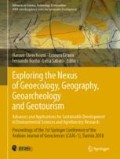Abstract
Arcellinida (testate lobose amoebae) are sensitive to arsenic (As) contamination from historic gold mining in Canadian subarctic lakes. Partial redundancy analysis revealed that As (9.4%) and S1 (labile organic matter, 8.9%) were the most important contributors to variance in faunal distribution. Arcellinida are important intermediary food web components in lacustrine environments. Microbes are their primary food source and elevated As-levels are known to suppress microbial growth (S1). The observed correlations are likely to be related to As-destabilization of Arcellinida microbial food supplies. To assess the utility of arcellinidans as tracers of temporal variation in As, we analyzed a freeze core from Frame Lake in the city of Yellowknife, which requires remediation following a steep decline in water quality through the 1960s that left it dead. Land-use activities in the area of the lake are well documented but little information is available regarding their impact on the lake itself. Geochemical, sedimentological and arcellinidan analysis showed that the system was non-depositional from the mid Holocene until ~1962 when the lake began to rapidly infill with highly As contaminated sediments. Since the early 1990s runoff from the catchment, and reduced lake circulation associated with installation of a causeway with rarely opened sluiceways at the only outlet, has caused eutrophication.
Access this chapter
Tax calculation will be finalised at checkout
Purchases are for personal use only
References
Galloway, J.M., Palmer, M., Swindles, G.T., Jamieson, H.E., Parsons, M.B., Sanei, H., Macumber, A.L., Patterson, R.T., Falck, H.: Organic matter control on the distribution of arsenic in lake sediments impacted by ~65 years of gold ore processing in subarctic Canada. Sci. Total Env. 622–623:1668–1679 (2017)
Nasser, N.A., Patterson, R.T., Roe, H.M., Galloway, J.M., Falck, H., Palmer, M.J., Spence, C., Sanei, H., Macumber, A.L., Neville, L.A.: Lacustrine arcellinina (testate amoebae) as bioindicators of arsenic contamination. Microb. Ecol. 72, 130–149 (2016)
Patterson, R.T., Roe, H.M., Swindles, G.T.: Development of a thecamoebian (testate amoebae) based transfer function for sedimentary phosphorous in lakes: applications to a record from southern Ontario Canada. Palaeogeography Paleoclimatology Palaeoecology. 348–349, 32–44 (2012)
Author information
Authors and Affiliations
Corresponding author
Editor information
Editors and Affiliations
Rights and permissions
Copyright information
© 2019 Springer Nature Switzerland AG
About this paper
Cite this paper
Patterson, R.T. et al. (2019). Arcellinida (Testate Lobose Amoebae) as Sensitive Bioindicators of Arsenic Contamination in Lakes. In: Chenchouni, H., Errami, E., Rocha, F., Sabato, L. (eds) Exploring the Nexus of Geoecology, Geography, Geoarcheology and Geotourism: Advances and Applications for Sustainable Development in Environmental Sciences and Agroforestry Research. CAJG 2018. Advances in Science, Technology & Innovation. Springer, Cham. https://doi.org/10.1007/978-3-030-01683-8_15
Download citation
DOI: https://doi.org/10.1007/978-3-030-01683-8_15
Published:
Publisher Name: Springer, Cham
Print ISBN: 978-3-030-01682-1
Online ISBN: 978-3-030-01683-8
eBook Packages: Earth and Environmental ScienceEarth and Environmental Science (R0)

